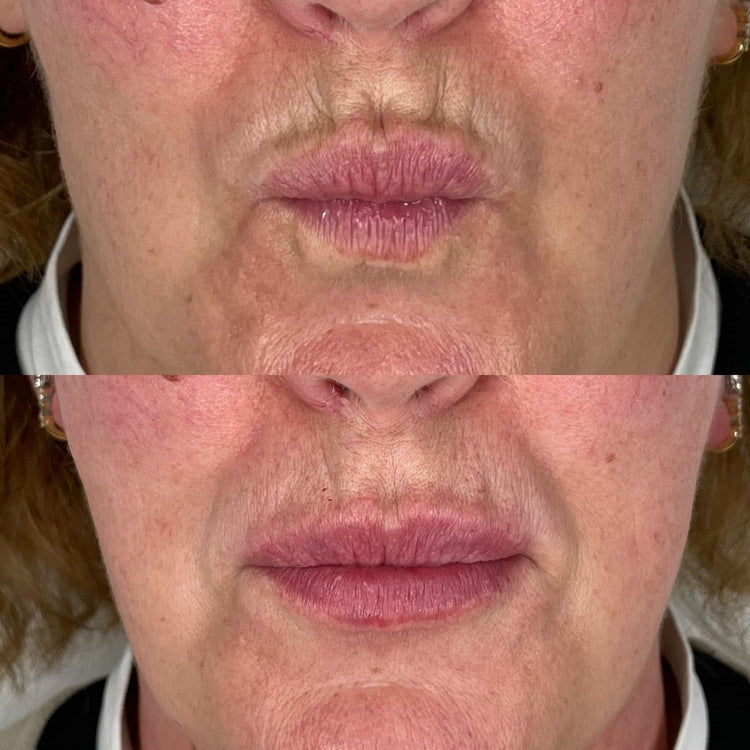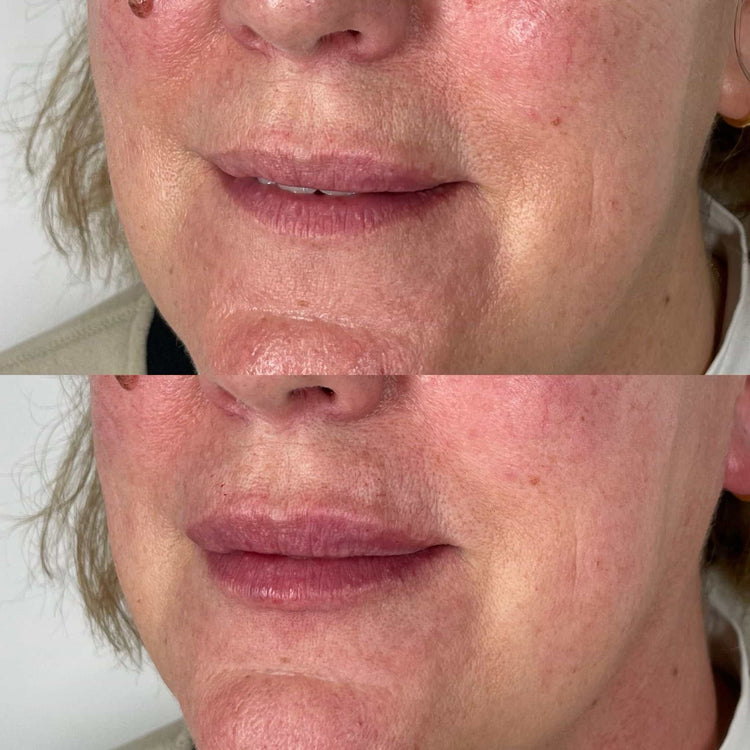What are Dermal Fillers?
Dermal fillers are injectable substances designed to add volume and shape to various areas of the face. Made from materials like hyaluronic acid, poly-L-lactic acid, or calcium hydroxylapatite, these gels are injected beneath the skin to smooth wrinkles, plump lips, and enhance facial contours.
Types of Dermal Fillers Used for Chin Augmentation
Chin augmentation using dermal fillers is a popular non-surgical option for enhancing the shape and projection of the chin. Different types of dermal fillers are utilized for this procedure, each with unique properties.
Hyaluronic acid (HA) fillers, such as Juvederm Voluma XC or Restylane Lyft, are commonly used for chin augmentation due to their ability to add volume and create a smoother contour. They are biocompatible and biodegradable, meaning they are naturally absorbed by the body over time.
Calcium hydroxylapatite fillers, like Radiesse, provide longer-lasting results as they stimulate collagen production, leading to more permanent volumization.
How Dermal Fillers Work
Dermal fillers are injectable substances used to add volume and shape to different areas of the face. They’re composed of materials like hyaluronic acid, poly-L-lactic acid, or calcium hydroxylapatite, which are injected beneath the skin.
These gels work by filling in wrinkles, plumping lips, and enhancing facial contours. The specific effects depend on the type of filler used and the area being treated.
Benefits of Chin Augmentation with Dermal Fillers
A well-defined chin can contribute significantly to a balanced and aesthetically pleasing facial profile. For individuals seeking to enhance their chin shape and projection without undergoing surgical procedures, dermal fillers offer a minimally invasive solution.
Enhanced Facial Profile
Chin augmentation with dermal fillers offers several benefits for enhancing facial aesthetics. It provides a non-surgical approach to shaping and projecting the chin, leading to a more balanced and defined profile. The procedure is relatively quick and minimally invasive, requiring only local anesthesia. Recovery time is also short, allowing patients to return to their normal activities soon after treatment.
Dermal fillers are biocompatible and biodegradable, minimizing the risk of adverse reactions or permanent changes to the facial structure. Furthermore, the results are often immediate and can last for several months to years, depending on the type of filler used and individual factors.
Improved Symmetry
One of the most significant benefits of chin augmentation with dermal fillers is the improvement in facial symmetry. By adding volume to a weak or receding chin, fillers can create balance between the jawline and the lower face. This harmonizes facial features and creates a more aesthetically pleasing appearance.
Non-Surgical Procedure
A well-defined chin can contribute significantly to a balanced and aesthetically pleasing facial profile. For individuals seeking to enhance their chin shape and projection without undergoing surgical procedures, dermal fillers offer a minimally invasive solution.
Chin augmentation with dermal fillers offers several benefits for enhancing facial aesthetics. It provides a non-surgical approach to shaping and projecting the chin, leading to a more balanced and defined profile. The procedure is relatively quick and minimally invasive, requiring only local anesthesia. Recovery time is also short, allowing patients to return to their normal activities soon after treatment.
Dermal fillers are biocompatible and biodegradable, minimizing the risk of adverse reactions or permanent changes to the facial structure. Furthermore, the results are often immediate and can last for several months to years, depending on the type of filler used and individual factors.
One of the most significant benefits of chin augmentation with dermal fillers is the improvement in facial symmetry. By adding volume to a weak or receding chin, fillers can create balance between the jawline and the lower face. This harmonizes facial features and creates a more aesthetically pleasing appearance.
Minimal Downtime
Chin augmentation with dermal fillers offers numerous benefits for individuals seeking a subtle yet impactful enhancement of their facial profile.
- Minimally Invasive: Unlike surgical procedures, chin augmentation with dermal fillers is non-surgical and requires only local anesthesia. The procedure is quick and relatively painless.
- Short Recovery Time: Due to its minimally invasive nature, downtime after treatment is minimal. Patients can typically return to their normal activities within a few days.
- Natural-Looking Results: Dermal fillers are designed to integrate seamlessly with the existing facial structure, resulting in natural-looking and subtle enhancements.
- Reversibility: In case of dissatisfaction or undesired outcomes, dermal fillers can be dissolved with hyaluronidase, allowing for reversibility of the procedure.
- Long-lasting Effects: Depending on the type of filler used and individual factors, the results of chin augmentation can last for several months to years.
Temporary and Reversible
Chin augmentation using dermal fillers provides numerous benefits for individuals seeking a subtle yet impactful enhancement of their facial profile.
One of the most significant advantages is that it offers a non-surgical approach. Unlike surgical chin implants, dermal fillers are injected beneath the skin, eliminating the need for incisions or general anesthesia. This makes the procedure less invasive and associated with minimal discomfort.
Another key benefit is the short recovery time. Patients typically experience only mild swelling and bruising that subsides within a few days, allowing them to return to their normal activities relatively quickly.
Dermal fillers also produce natural-looking results. These injectable gels are designed to seamlessly integrate with the existing facial structure, creating subtle enhancements rather than dramatic changes.
The reversibility of dermal fillers is another appealing aspect. If a patient is unhappy with the results or experiences any complications, the filler can be dissolved using an enzyme called hyaluronidase. This allows for correction or modification of the treatment if necessary.
Finally, dermal fillers offer long-lasting effects, although the duration varies depending on the type of filler used and individual factors. Some fillers can last for several months, while others may provide results that persist for up to two years.
Procedure for Chin Augmentation with Dermal Fillers
Chin augmentation using dermal fillers is a popular non-surgical option for enhancing the shape and projection of the chin. Different types of dermal fillers are utilized for this procedure, each with unique properties.
Consultation and Assessment
The process begins with a consultation where a qualified healthcare professional will assess your facial structure, discuss your desired outcome, and determine if you are a suitable candidate for chin augmentation with dermal fillers. During the consultation, it is important to openly communicate your expectations, concerns, and any medical history relevant to the procedure.
Following the consultation, if you decide to proceed, the actual treatment will involve injecting the chosen dermal filler into specific points beneath the skin of the chin. Local anesthesia may be applied to minimize any discomfort during the procedure.

The amount of filler used and the injection technique will be tailored to your individual needs and desired results. After the injections, you may experience mild swelling, redness, or bruising, which typically subside within a few days.
Regular follow-up appointments with your healthcare professional will ensure optimal results and allow for any necessary adjustments or touch-ups.
Treatment Process
Chin augmentation with dermal fillers is a popular non-surgical option for enhancing the shape and projection of the chin. Different types of dermal fillers are utilized for this procedure, each with unique properties.
The process begins with a consultation where a qualified healthcare professional will assess your facial structure, discuss your desired outcome, and determine if you are a suitable candidate for chin augmentation with dermal fillers. During the consultation, it is important to openly communicate your expectations, concerns, and any medical history relevant to the procedure.
Following the consultation, if you decide to proceed, the actual treatment will involve injecting the chosen dermal filler into specific points beneath the skin of the chin. Local anesthesia may be applied to minimize any discomfort during the procedure.
The amount of filler used and the injection technique will be tailored to your individual needs and desired results. After the injections, you may experience mild swelling, redness, or bruising, which typically subside within a few days.
Regular follow-up appointments with your healthcare professional will ensure optimal results and allow for any necessary adjustments or touch-ups.
Aftercare Instructions
Chin augmentation with dermal fillers is a popular non-surgical option for enhancing the shape and projection of the chin. Different types of dermal fillers are utilized for this procedure, each with unique properties.
The process begins with a consultation where a qualified healthcare professional will assess your facial structure, discuss your desired outcome, and determine if you are a suitable candidate for chin augmentation with dermal fillers. During the consultation, it is important to openly communicate your expectations, concerns, and any medical history relevant to the procedure.
Following the consultation, if you decide to proceed, the actual treatment will involve injecting the chosen dermal filler into specific points beneath the skin of the chin. Local anesthesia may be applied to minimize any discomfort during the procedure.
The amount of filler used and the injection technique will be tailored to your individual needs and desired results. After the injections, you may experience mild swelling, redness, or bruising, which typically subside within a few days.
Regular follow-up appointments with your healthcare professional will ensure optimal results and allow for any necessary adjustments or touch-ups.
Aftercare is crucial for ensuring the best possible results from chin augmentation with dermal fillers. Following these guidelines will help minimize complications and optimize your outcome.
Avoid touching or massaging the treated area for at least 24 hours after the procedure to prevent bruising and swelling.
Apply a cold compress to the treated area for 10-15 minutes at a time, several times a day, during the first 24-48 hours to reduce inflammation.
Use gentle cleansers and avoid any harsh skincare products or exfoliating scrubs on the treated area for at least a week.
Sleep with your head elevated to minimize swelling.
Refrain from strenuous activity, exercise, or facial massage for at least a few days.
Avoid consuming alcohol and smoking for a few days after the procedure, as these can interfere with healing.
If you experience any unusual symptoms, such as excessive swelling, pain, redness, or infection, contact your healthcare professional immediately.
Risks and Side Effects
While dermal fillers offer many benefits for chin augmentation, it’s important to be aware of potential risks and side effects. These can range from mild and temporary (such as bruising, swelling, or redness) to more serious complications (like infection or allergic reactions). It’s crucial to have a consultation with a qualified healthcare professional to discuss your medical history, assess your suitability for the procedure, and understand the potential risks involved.
Bruising and Swelling
Dermal fillers are generally safe when administered by a qualified professional, but like any medical procedure, there are potential risks and side effects. Bruising and swelling are common and usually subside within a few days.
Other possible side effects include redness, tenderness, itching, or pain at the injection site. In rare cases, more serious complications such as infection, allergic reactions, or vascular occlusion (blockage of blood vessels) can occur.
It’s essential to discuss your medical history and any allergies with your healthcare provider before undergoing chin augmentation with dermal fillers.
Infection
One of the potential risks associated with dermal filler injections is infection. Like any procedure that involves breaking the skin, there is a risk of bacteria entering the injection site and causing an infection.
To minimize this risk, it’s crucial to choose a qualified and experienced injector who follows strict sterilization protocols. Before the procedure, the area will be cleaned thoroughly with antiseptic solutions.
After the treatment, it’s important to follow your injector’s instructions for aftercare to promote healing and prevent infection.
If you experience any signs of infection, such as redness, swelling, warmth, pain, or pus at the injection site, contact your healthcare professional immediately.
Allergic Reactions
Allergic reactions are a potential risk with dermal fillers, although they are relatively rare. These reactions can range from mild (e.g., itching, redness) to severe (anaphylaxis). It’s crucial to inform your injector about any known allergies, especially to ingredients commonly found in dermal fillers.
To minimize the risk of an allergic reaction, a patch test may be performed before the procedure using a small amount of filler. If you experience any adverse reactions during the patch test, the procedure should not be performed.
Lumps or Nodules
Risks and side effects associated with chin augmentation using dermal fillers are generally mild and temporary, but it is important to be aware of potential complications. Bruising, swelling, redness, tenderness, itching, or pain at the injection site are common occurrences that usually subside within a few days.
In rare cases, more serious side effects may occur, including infection, allergic reactions, vascular occlusion (blockage of blood vessels), or filler migration (movement of the filler from its intended location). It is essential to have a consultation with a qualified healthcare professional to discuss your medical history, assess your suitability for the procedure, and understand the potential risks involved.
Always choose an experienced injector who follows strict sterilization protocols and prioritizes patient safety.
Choosing a Qualified Provider
Choosing a qualified provider is crucial when considering dermal fillers for chin augmentation. A skilled and experienced injector will have in-depth knowledge of facial anatomy, filler types, and injection techniques. They should also be licensed and certified to practice medicine or injectables in your state.
Experience and Expertise
When choosing a qualified provider for chin augmentation with dermal fillers, experience and expertise are paramount. Look for an injector who has extensive experience specifically performing chin augmentation procedures. Inquire about their training, certifications, and the number of chin augmentation procedures they have successfully completed.
A skilled injector will be able to assess your facial structure, understand your desired outcome, and create a personalized treatment plan tailored to your needs. They should also be able to address any concerns you may have and provide realistic expectations about the results.
Board Certification
Choosing a qualified provider is crucial when considering dermal fillers for chin augmentation.
Board certification ensures that a healthcare professional has met rigorous standards of education, training, and experience in their field. When it comes to medical procedures involving injectables like dermal fillers, board certification provides assurance that the practitioner possesses the necessary knowledge and expertise to perform the procedure safely and effectively.
Patient Reviews and Testimonials
Choosing a qualified provider is essential for a successful and safe chin augmentation procedure using dermal fillers. A skilled injector will have in-depth knowledge of facial anatomy, different filler types, and appropriate injection techniques. Look for an injector who is licensed and certified in your state and has extensive experience performing chin augmentation procedures.
Patient reviews and testimonials can offer valuable insights into the experiences of others who have undergone chin augmentation with dermal fillers. Reading online reviews on platforms such as RealSelf or Google Reviews can provide a glimpse into patients’ satisfaction levels, results achieved, and any potential concerns they may have had. Keep in mind that individual experiences can vary, and it’s essential to consider multiple sources and look for patterns or recurring themes in the feedback.
Cost of Chin Augmentation with Dermal Fillers

The cost of chin augmentation with dermal fillers varies depending on several factors, including the type and amount of filler used, the injector’s experience and location, and the specific anatomy of your face.
On average, you can expect to pay anywhere from $500 to $2,000 per treatment session.
Multiple treatments may be necessary to achieve the desired results, so it’s essential to factor that into your budget. It is also important to discuss payment options and potential financing plans with the injector beforehand.
Long-Term Considerations
Chin augmentation using dermal fillers can enhance facial aesthetics by providing a subtle yet impactful change to the profile. When considering this procedure, it is important to understand the long-term considerations involved, such as filler longevity and potential repeat treatments.
Maintenance Treatments
Long-term considerations for chin augmentation with dermal fillers involve understanding that the effects are not permanent. Different types of fillers have varying lifespans, ranging from several months to a couple of years.
As the body naturally breaks down the filler over time, touch-up treatments will be needed to maintain the desired results.
The frequency of these touch-ups will depend on the type of filler used, your individual metabolism, and how long you wish to preserve the augmented chin shape.
Regular maintenance treatments ensure that your chin augmentation looks its best over time. Maintaining open communication with your injector about your desired outcomes and aesthetic goals will help create a customized plan for your touch-up appointments.
It’s essential to schedule follow-up appointments with your injector as recommended to monitor the filler’s longevity, assess any changes in facial structure, and address any concerns you may have.
Natural Facial Aging
The longevity of chin augmentation results achieved with dermal fillers varies depending on several factors. Hyaluronic acid (HA) fillers, such as Juvederm Voluma XC or Restylane Lyft, typically last 6 to 18 months, while calcium hydroxylapatite fillers, like Radiesse, can provide longer-lasting results, sometimes up to two years due to their ability to stimulate collagen production.
Repeat treatments are necessary to maintain the desired chin augmentation effects as the body gradually breaks down the filler over time. The frequency of touch-up appointments depends on individual factors such as metabolism, lifestyle, and how long you wish to sustain the augmented look. Regular follow-up with your injector is crucial for assessing the longevity of the filler and ensuring optimal results.
Remember, consistent maintenance treatments are key to preserving the desired aesthetic outcome over the long term.
Learn more about non-surgical face contouring with dermal fillers at It’s Me & You Clinic
- Why Do My Teeth Hurt After Lip Filler - November 8, 2025
- What Is The Best Procedure For Sagging Neck? - November 5, 2025
- What Are The Best CBD Gummies For Mental Focus And Clarity - November 4, 2025
